Modelling and Comparative Analysis of Epoxy-Fly-Ash Composite with Alloys for Bracket Application
Abstract
1. Introduction
2. Materials and Methods
2.1. Calculations
2.2. Numerical Modelling
3. Results and Discussion
4. Conclusions
Author Contributions
Funding
Data Availability Statement
Acknowledgments
Conflicts of Interest
References
- Kržan, M.; Azinović, B. Cyclic Response of Insulated Steel Angle Brackets Used for Cross-Laminated Timber Connections. Eur. J. Wood Wood Prod. 2021, 79, 691–705. [Google Scholar] [CrossRef]
- Rezvani, S.; Zhou, L.; Ni, C. Experimental Evaluation of Angle Bracket Connections in CLT Structures under In- and out-of-Plane Lateral Loading. Eng. Struct. 2021, 244, 112787. [Google Scholar] [CrossRef]
- Samal, S.K.; Vishwanatha, H.M.; Saxena, K.K.; Behera, A.; Nguyen, T.A.; Behera, A.; Prakash, C.; Dixit, S.; Mohammed, K.A. 3D-Printed Satellite Brackets: Materials, Manufacturing and Applications. Crystals 2022, 12, 1148. [Google Scholar] [CrossRef]
- Botkin, K.J. Shelving Systems and Components Therefor. U.S. Patent US20100000449A1, 7 January 2010. [Google Scholar]
- Dhulia, J.K.; Maniar, N.P. Design, Modelling and Manufacturing of 16 Cylinder Hydraulic Fixture with Automated Clamping System. J. Phys. Conf. Ser. 2019, 1240, 012036. [Google Scholar] [CrossRef]
- Shoghi, K.; Barrans, S.M.; Rao, H. V Stress in V-Section Band Clamps. Proc. Inst. Mech. Eng. Part C J. Mech. Eng. Sci. 2004, 218, 251–261. [Google Scholar] [CrossRef]
- Linjawi, A.I.; Hashim, H.A. The Effect of Volatile Oils on De-Bonding of Polycarbonate Bracket Reinforced with Ceramic Filler: A Quantitative Study (Part 1). Eur. J. Dent. Oral Health 2022, 3, 1–8. [Google Scholar] [CrossRef]
- Gillberg, L.; Sandberg, C. Developing Design Guidelines for Load Carrying Sheet Metal Components with Regards to Manufacturing Method. Master’s Thesis, Production Engineering, School of Industrial Engineering and Management (ITM), KTH, Stockholm, Sweden, 2017. [Google Scholar]
- Ferchow, J.; Bühler, M.; Schlüssel, M.; Zumofen, L.; Klahn, C.; Hofmann, U.; Kirchheim, A.; Meboldt, M. Design and Validation of a Sheet Metal Clamping System for Additive Manufacturing and Post-Processing. Int. J. Adv. Manuf. Technol. 2022, 119, 7947–7967. [Google Scholar] [CrossRef]
- Gavric, I.; Fragiacomo, M.; Ceccotti, A. Cyclic Behaviour of Typical Metal Connectors for Cross-Laminated (CLT) Structures. Mater. Struct. 2015, 48, 1841–1857. [Google Scholar] [CrossRef]
- Roberto, T.; Ian, S. Experimental Characterization of Monotonic and Cyclic Loading Responses of CLT Panel-To-Foundation Angle Bracket Connections. J. Mater. Civ. Eng. 2015, 27, 4014189. [Google Scholar] [CrossRef]
- D’Arenzo, G.; Rinaldin, G.; Fossetti, M.; Fragiacomo, M. An Innovative Shear-Tension Angle Bracket for Cross-Laminated Timber Structures: Experimental Tests and Numerical Modelling. Eng. Struct. 2019, 197, 109434. [Google Scholar] [CrossRef]
- Lukacs, I.; Björnfot, A.; Tomasi, R. Strength and Stiffness of Cross-Laminated Timber (CLT) Shear Walls: State-of-the-Art of Analytical Approaches. Eng. Struct. 2019, 178, 136–147. [Google Scholar] [CrossRef]
- Rezvani, S.; Zhou, L. Numerical Modelling Analysis of Angle Bracket Connections Used in Cross Laminated Timber Constructions. Modul. Offsite Constr. Summit Proc. 2019, 421–428. [Google Scholar] [CrossRef]
- Luca, P.; Roberto, S. Influence of Wall Assembly on Behaviour of Cross-Laminated Timber Buildings. Proc. Inst. Civ. Eng. Struct. Build. 2015, 168, 275–286. [Google Scholar] [CrossRef]
- Pozza, L.; Saetta, A.; Savoia, M.; Talledo, D. Angle Bracket Connections for CLT Structures: Experimental Characterization and Numerical Modelling. Constr. Build. Mater. 2018, 191, 95–113. [Google Scholar] [CrossRef]
- Jin, F.-L.; Li, X.; Park, S.-J. Synthesis and Application of Epoxy Resins: A Review. J. Ind. Eng. Chem. 2015, 29, 1–11. [Google Scholar] [CrossRef]
- Hiremath, S.; Shrishail, H.M.; Kulkarni, S.M. Progression and Characterization of Polydimethylsiloxane-Carbon Black Nanocomposites for Photothermal Actuator Applications. Sens. Actuators A Phys. 2021, 319, 112522. [Google Scholar] [CrossRef]
- Sim, J.; Kang, Y.; Kim, B.J.; Park, Y.H.; Lee, Y.C. Preparation of Fly Ash/Epoxy Composites and Its Effects on Mechanical Properties. Polymers 2020, 12, 79. [Google Scholar] [CrossRef]
- Kishore; Kulkarni, S.M.; Sharathchandra, S.; Sunil, D. On the Use of an Instrumented Set-up to Characterize the Impact Behaviour of an Epoxy System Containing Varying Fly Ash Content. Polym. Test. 2002, 21, 763–771. [Google Scholar] [CrossRef]
- Chand, N. SEM Observation of Fractured Flyash-Polyester Composites. J. Mater. Sci. Lett. 1988, 7, 36–38. [Google Scholar] [CrossRef]
- Wang, R.M.; Zheng, S.R.; Zheng, Y.P. Polymer Matrix Composites and Technology; Woodhead Publishing Series in Composites Science and Engineering; Elsevier Science: Amsterdam, The Netherlands, 2011; ISBN 9780857092212. [Google Scholar]
- Rajak, D.K.; Pagar, D.D.; Kumar, R.; Pruncu, C.I. Recent Progress of Reinforcement Materials: A Comprehensive Overview of Composite Materials. J. Mater. Res. Technol. 2019, 8, 6354–6374. [Google Scholar] [CrossRef]
- Silori, P.; Shaikh, A.; Kumar, K.C.N.; Tandon, T. Finite Element Analysis of Traction Gear Using ANSYS. Mater. Today Proc. 2015, 2, 2236–2245. [Google Scholar] [CrossRef]
- Wollmann, M.; Kiese, J.; Wagner, L. Properties and Applications of Titanium Alloys in Transport. In Proceedings of the 12th World Conference on Titanium, Beijing, China, 19–24 June 2011; Volume 2, pp. 837–844. [Google Scholar]
- Baddoo, N.R. Stainless Steel in Construction: A Review of Research, Applications, Challenges and Opportunities. J. Constr. Steel Res. 2008, 64, 1199–1206. [Google Scholar] [CrossRef]
- Jayasathyakawin, S.; Ravichandran, M.; Baskar, N.; Chairman, C.A.; Balasundaram, R. Mechanical Properties and Applications of Magnesium Alloy—Review. Mater. Today Proc. 2020, 27, 909–913. [Google Scholar] [CrossRef]
- Sathish, T.; Dinesh Kumar, S.; Karthick, S. Modelling and Analysis of Different Connecting Rod Material through Finite Element Route. Mater. Today Proc. 2020, 21, 971–975. [Google Scholar] [CrossRef]
- Gautam, A. Static Stress Analysis of Connecting Rod Using Finite Element Approach. IOSR J. Mech. Civ. Eng. 2013, 10, 47–51. [Google Scholar] [CrossRef]
- Akhmadullina, G.; Shmelev, G.; Antonov, A.; Gimazetdinov, A.; Fahrutdinov, R. Numerical Modeling and Optimization of Geometric Parameters of a Composite Bracket. IOP Conf. Ser. Mater. Sci. Eng. 2020, 890, 12051. [Google Scholar] [CrossRef]
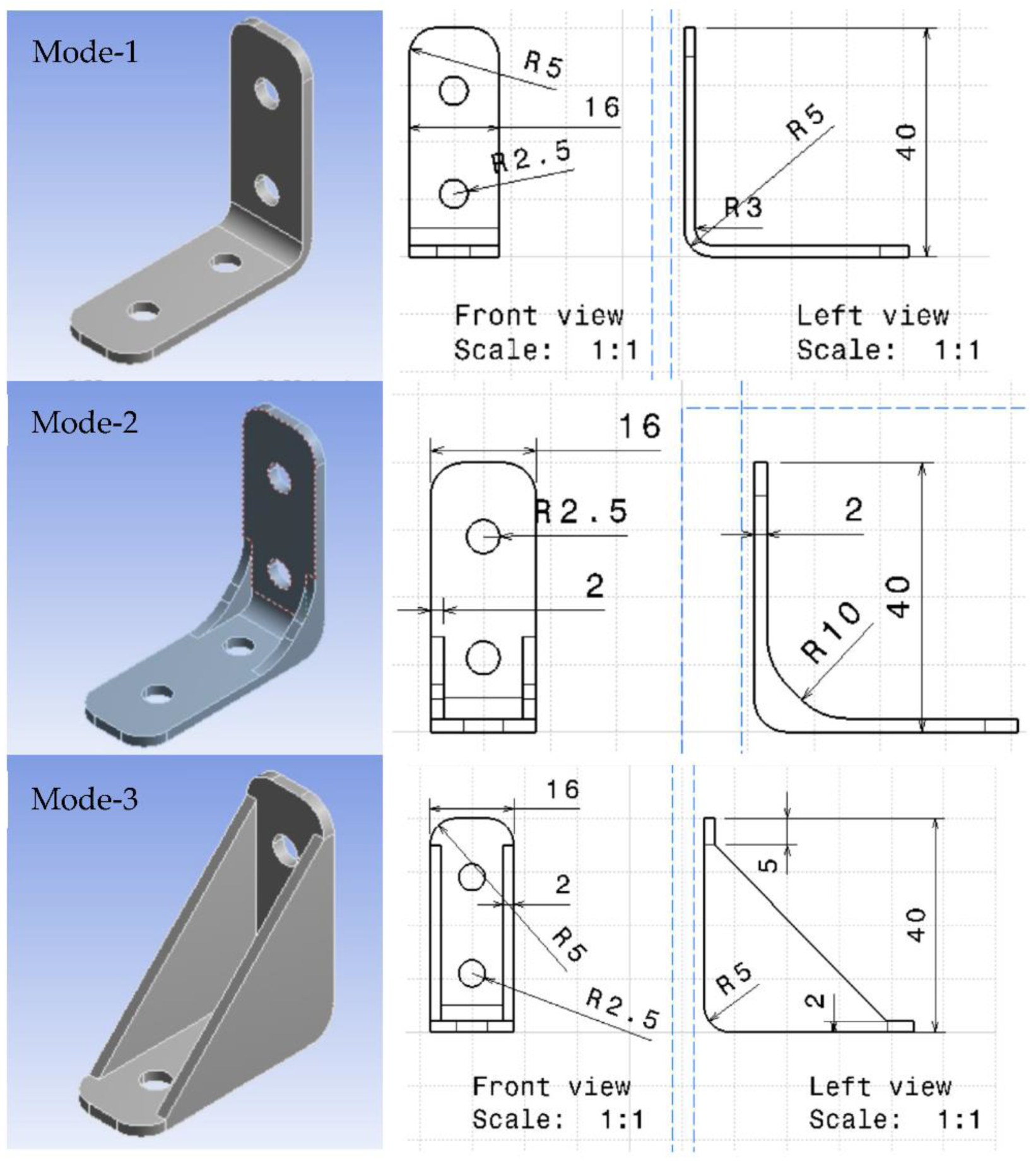


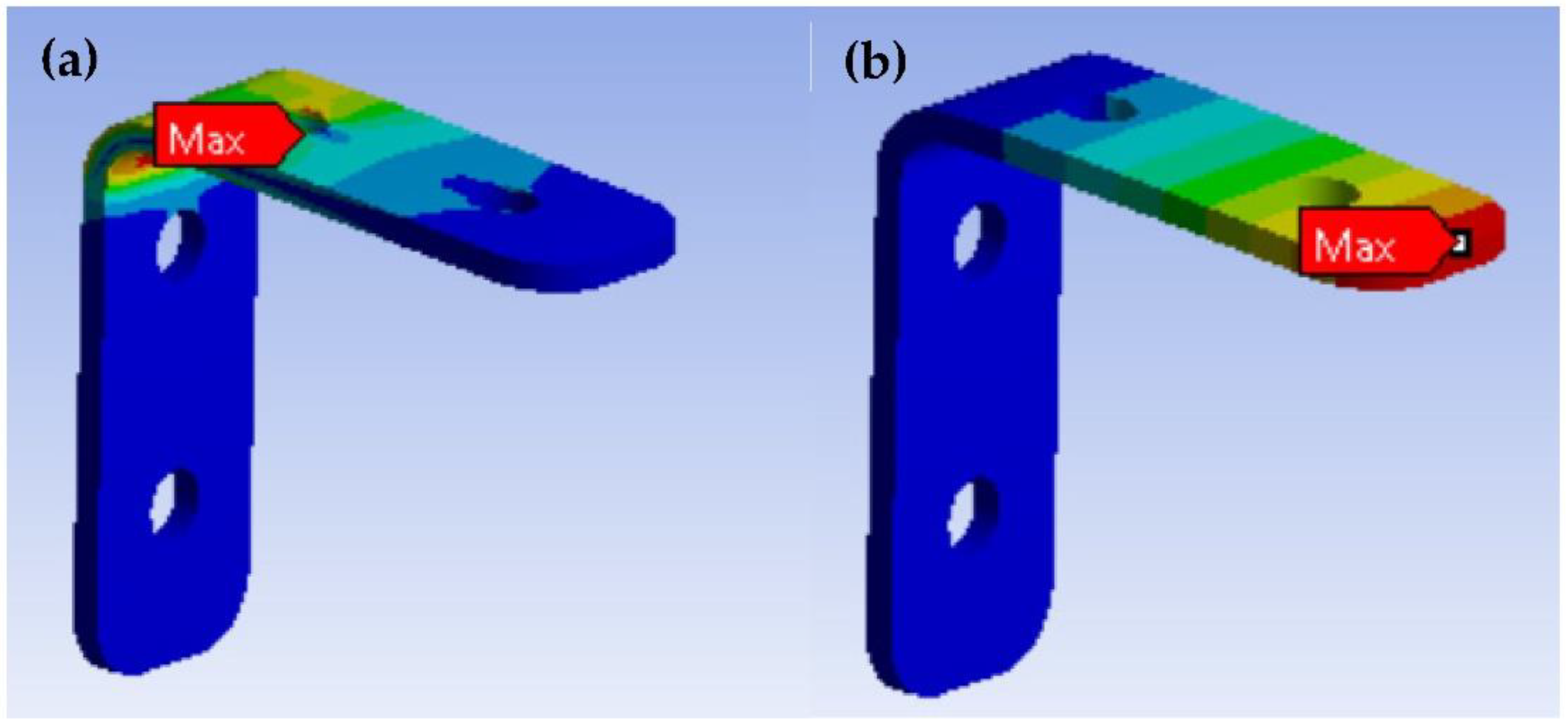

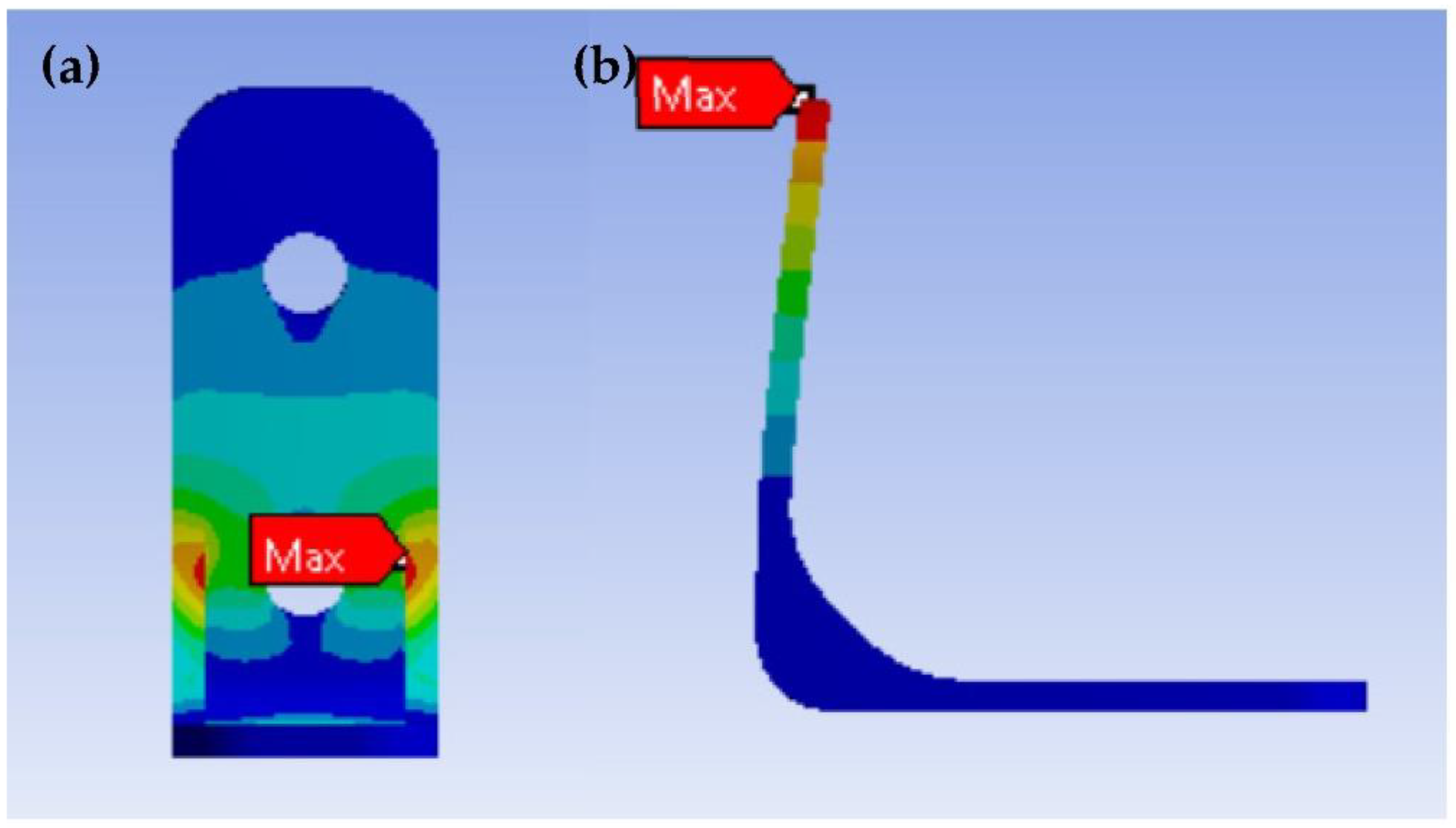
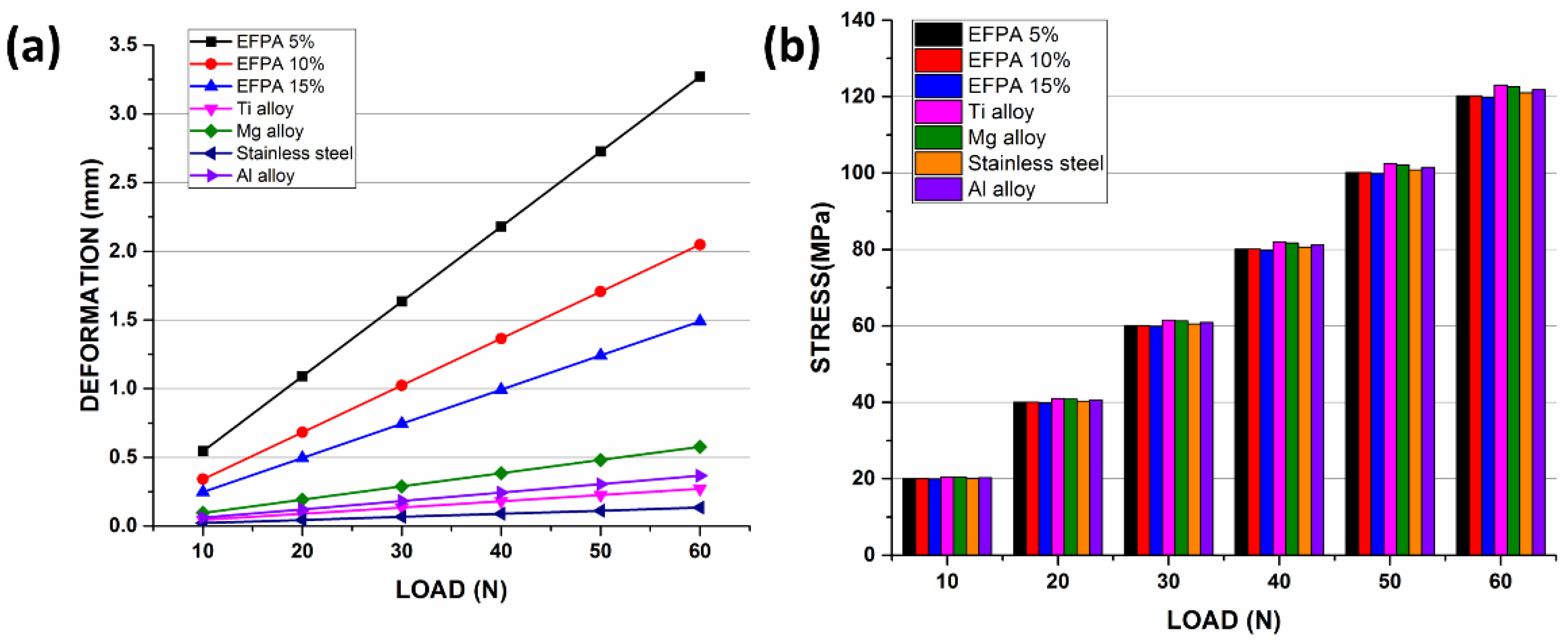

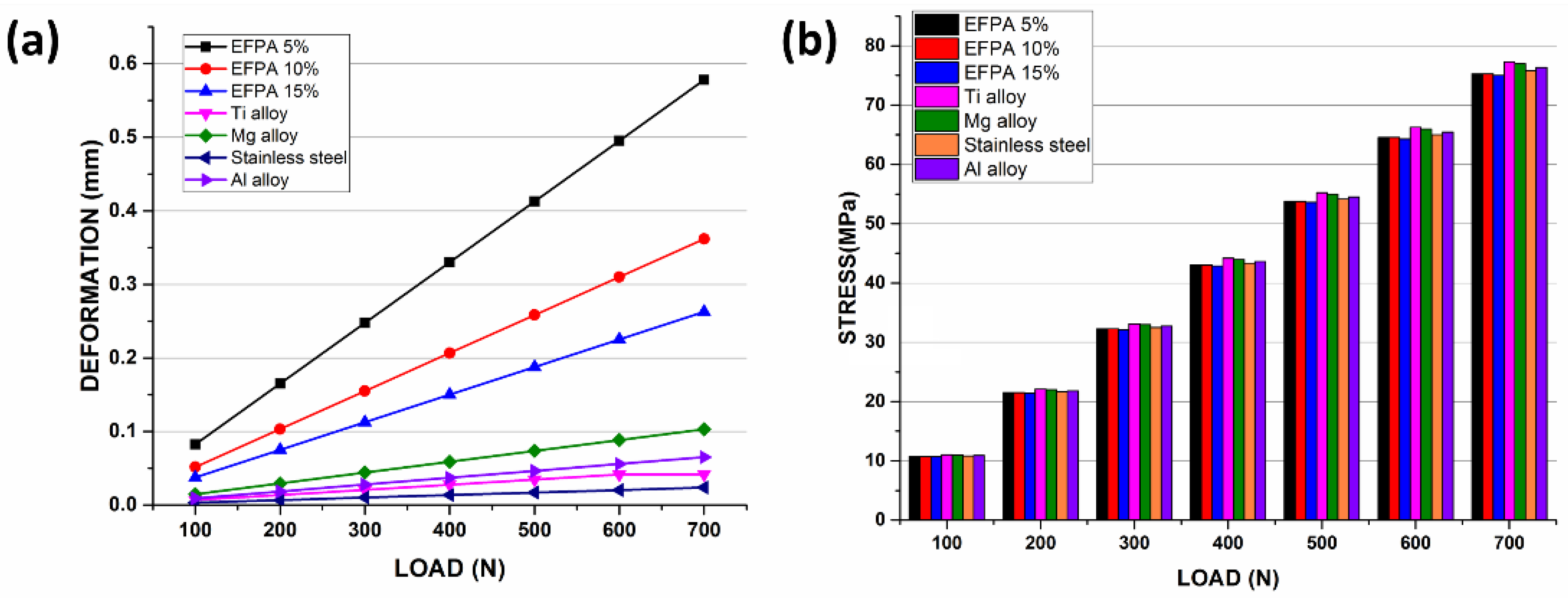
| Material | Density (kg/m−3) | Youngs Modulus (GPa) | Poisson Ratio |
|---|---|---|---|
| Stainless steel | 7750 | 193 | 0.31 |
| Magnesium alloy | 1800 | 45 | 0.35 |
| Titanium alloy | 4620 | 96 | 0.36 |
| Aluminum alloy | 2770 | 71 | 0.33 |
| Material | Density (kg/m−3) | Youngs Modulus (GPa) | Compressive Modulus (GPa) | Poisson Ratio |
|---|---|---|---|---|
| Fly-ash | 1180 | 98 | - | 0.2 |
| Epoxy | 1200 | 3.2 | 2.8 | 0.3 |
Publisher’s Note: MDPI stays neutral with regard to jurisdictional claims in published maps and institutional affiliations. |
© 2022 by the authors. Licensee MDPI, Basel, Switzerland. This article is an open access article distributed under the terms and conditions of the Creative Commons Attribution (CC BY) license (https://creativecommons.org/licenses/by/4.0/).
Share and Cite
Raghunandan, A.B.; Chiniwar, D.S.; Hiremath, S.; Sondar, P.; Vishwanatha, H.M. Modelling and Comparative Analysis of Epoxy-Fly-Ash Composite with Alloys for Bracket Application. J. Compos. Sci. 2022, 6, 358. https://doi.org/10.3390/jcs6120358
Raghunandan AB, Chiniwar DS, Hiremath S, Sondar P, Vishwanatha HM. Modelling and Comparative Analysis of Epoxy-Fly-Ash Composite with Alloys for Bracket Application. Journal of Composites Science. 2022; 6(12):358. https://doi.org/10.3390/jcs6120358
Chicago/Turabian StyleRaghunandan, Abhijay B., Dundesh S. Chiniwar, Shivashankar Hiremath, Pavankumar Sondar, and H. M. Vishwanatha. 2022. "Modelling and Comparative Analysis of Epoxy-Fly-Ash Composite with Alloys for Bracket Application" Journal of Composites Science 6, no. 12: 358. https://doi.org/10.3390/jcs6120358
APA StyleRaghunandan, A. B., Chiniwar, D. S., Hiremath, S., Sondar, P., & Vishwanatha, H. M. (2022). Modelling and Comparative Analysis of Epoxy-Fly-Ash Composite with Alloys for Bracket Application. Journal of Composites Science, 6(12), 358. https://doi.org/10.3390/jcs6120358










